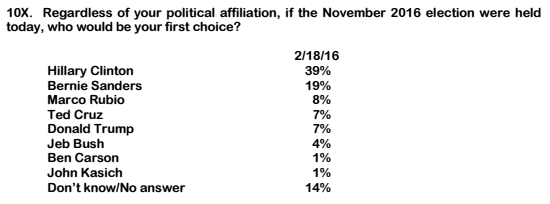Trump “won” the Hispanic vote in Nevada, the argument goes. But there’s a primary cause to Donald Trump’s reported success with Hispanics.
As long as the election is in its nominating process, the GOP frontrunner will remain exposed to only a small sliver of Hispanic voters. Considered as a group, most of them identify as Democrats, and a majority say they will vote for a Democratic presidential nominee this year no matter what. Then there’s this: The first three states on the Republican primary calendar have tiny Hispanic populations, and the sample sizes of Hispanics who have voted in GOP primaries thus far — even in Nevada — are statistically insignificant.
A minority of Hispanics identify as Republicans and vote in GOP primaries
According to a Washington Post-Univision poll, four times as many Hispanics identify as Democrat than they do Republican. 56 percent describe themselves as Democrats, 14 percent describe themselves as Republicans, and 27 percent call themselves independent. And of those who say they would participate in a presidential primary or caucus, 61 percent said they would take a Democratic ballot, compared to just 20 percent who said they would vote on the Republican side.
There aren’t many Hispanic voters in the Republican primary relative to the Democratic contest. And a general election would presumably include a combination of voters in both groups, as well as voting Hispanics who didn’t participate in a primary.
Hispanic support for a Democratic candidate is hardened
For the Republican nominee, “winning” the Hispanic vote will have more to do with meeting a target percentage of support than capturing a majority. In the Post-Univision report, 51 percent say they will vote for a Democrat “no matter who it is”. That number is just 14 percent for a generic Republican candidate. Without taking party names into account, there are the eye-catching results of this question, too:

There aren’t large Hispanic populations in the first three primary states
According to census data, these are the percentages of the Hispanic/Latino population in the first three primary states this year:
Iowa: 5.6 percent
New Hampshire: 3.3 percent
South Carolina: 5.4 percent
For comparison, 17.4 percent of the United States comprises Hispanics/Latinos, making these states poor representative samples of the entire populace.
Hispanics have made up a fraction of GOP voters thus far
Entrance and exit poll data from the first four primary states reveal that Hispanics have made up teeny fractions of the total Republican vote thus far. These are the percentages of Republican voters who have identified as Hispanic or Latino by state:
Iowa: 2 percent
New Hampshire: 1 percent
South Carolina: 1 percent
Nevada: 8 percent
The first three states produced statistically insignificant samples for the purposes of determining who won the support of voting Hispanics. And although Trump “won” the vote among this demographic in Nevada with a reported 45 percent, the margin of error for that figure could be in excess of 10 percent, as FiveThirtyEight notes.
The bottom line is that there is virtually zero meaningful data so far to prove that Trump is exceeding expectations with Hispanic voters. For one, he hasn’t been tested among the general population of Hispanics across the country. And the level of Republican-voting Hispanics in the primaries so far hasn’t provided a sufficient amount of information to make a fair judgment.
What we do know is that Trump has subterranean levels of popularity in the Hispanic community. According to the Post-Univision poll, Marco Rubio has a net +8 rating, and Ted Cruz’s isn’t awful at -6. Trump, however, has a shocking -64. Bluto would be impressed.
What’s more, it may become more difficult for Hispanic voters to disassociate some of Trump’s incendiary rhetoric on immigration from the Republican brand were he to become the nominee. 74 percent of the survey respondents said they are “offended” by his views on immigration — but only 19 percent said they believe those views “represent the views of the Republican party”. One could guess how that number would change if his name appears on a general election ballot.
But there’s a flip side. Hispanics aren’t close to being a single-issue demographic. In fact, immigration isn’t even the most important issue to them, per the Post-Univision survey — that would be jobs and the economy, which nets 33 percent. (Immigration is second at 17 percent.) And for those terrified of Trump’s hardline immigration stance, this question and result is worth keeping in mind:

This figure doesn’t indicate that opposition to a path to citizenship is a disqualifying characteristic, given the number of Hispanics (51 percent) who say they’ll support a Democrat regardless. After all, as columnist Ruben Navarrette observes, the Hispanic vote is a complex topic.
“The Latino community in the United States—and especially the nearly 70 percent of that population that is Mexican or Mexican-American—is highly aspirational,” he writes. “They don’t settle. They want better lives for themselves and their children. They want success. They don’t hate Trump. They want to be Trump.”
Now the question is do they vote Trump.

